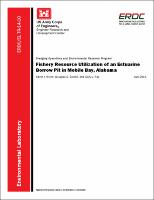Please use this identifier to cite or link to this item:
https://hdl.handle.net/11681/7132| Title: | Fishery resource utilization of an estuarine borrow pit in Mobile Bay, Alabama |
| Authors: | Reine, Kevin J. Clarke, Douglas G. Ray, Gary L. |
| Keywords: | Restoration Fisheries acoustics Benthic sampling Water quality Dredged material Dredging Mobile Bay (Ala.) Environmental restoration Environmental management Aquatic ecosystems Estuary Estuaries Dredging Operations and Environmental Research Program (U.S.) |
| Publisher: | Engineer Research and Development Center (U.S.) |
| Series/Report no.: | Technical Report (Engineer Research and Development Center (U.S.)) ; no. ERDC/EL TR-14-10 |
| Abstract: | Many inshore coastal habitats have been altered by sand excavation for commercial and beach nourishment purposes, producing artificial holes and depressions. These features are characterized by poor sediment, water quality, altered circulation patterns, water column stratification, and the accumulation of fine sediments. These parameters are frequently cited as factors for degraded habitat found in borrow pits. This report summarizes the results of baseline and Year 1 post-restoration monitoring of Brookley (partially restored) and Airport Holes (control), located in Mobile Bay, Alabama. Monitoring efforts included a combination of fisheries acoustic techniques to determine fish density and spatial and temporal distribution patterns, conventional fisheries to determine species composition, length, CPUE, water quality, and sediment grain size analysis. Benthic macroinvertebrates were sampled seasonally to evaluate recruitment and community structure. Postrestoration results indicated a significant improvement in water quality conditions in Brookley Hole. Hypoxic/anoxic conditions present during prerestoration were absent during postrestoration sampling. Prerestoration infaunal sampling indicated that both holes supported impoverished benthic assemblages comprised largely of opportunistic, disturbance-adapted infauna. Species abundance increased significantly during postrestoration sampling; however was still depressed when compared to the surrounding bay waters. One contributing factor is that water depths in Brookley Hole are still greater than the surrounding bay waters. There was no significant difference in abundance, taxa, or species composition among sites or the pre- and postplacement time periods, indicating that finfish utilization was not affected by the placement of dredged material. Brookley Hole remains a suitable candidate for either partial or complete filling with dredged material. |
| Description: | Technical Report |
| Gov't Doc #: | ERDC/EL TR-14-10 |
| Rights: | Approved for public release; distribution is unlimited |
| URI: | http://hdl.handle.net/11681/7132 |
| Appears in Collections: | Technical Report Technical Report |
Files in This Item:
| File | Description | Size | Format | |
|---|---|---|---|---|
| ERDC-EL TR-14-10.pdf | ERDC/EL TR-14-10 | 5.39 MB | Adobe PDF |  View/Open |